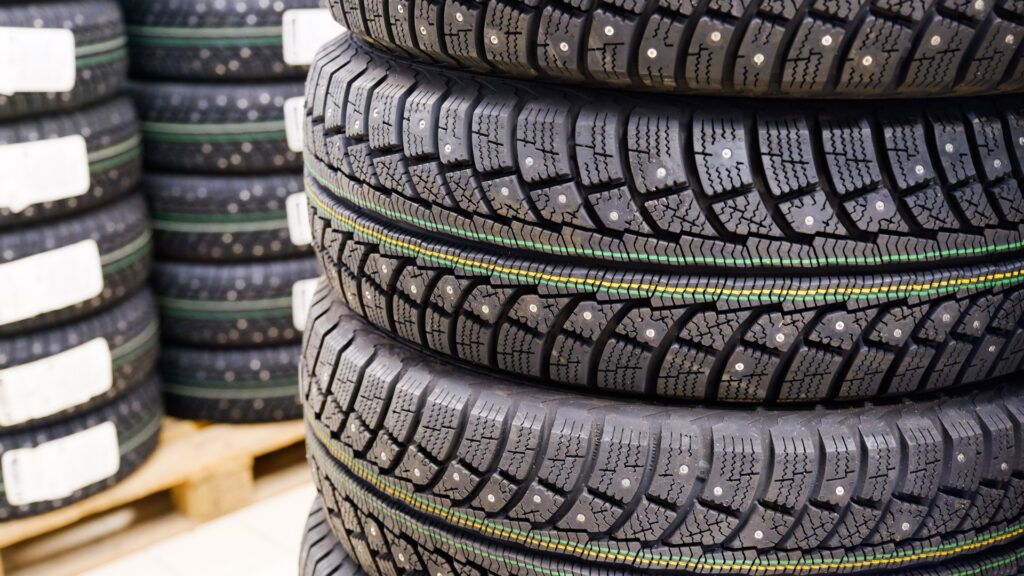Table of Contents Show
If you live in the Northeast or Mountain West, you’re probably familiar with studded tires. But these tires aren’t even allowed on the roadways in other parts of the country.
So why not? Are these tires worth the investment to provide safe driving conditions during the winter season, or are they too much of a hassle when you can just use winter tires?
Let’s learn more about these winter tires, and you can decide for yourself!
What Are Studded Tires?
You use studded tires during winter travel to help grip slick roads. The studs aren’t removable.
They look like small metal spikes inserted in the tread that protrude about 1/32 of an inch and act like claws against the icy and snowy roads.
You can find them at almost any tire shop, including large chains like Walmart, Amazon, and Tire Rack.

How Do Studded Tires Work?
Consider studded tires like cleats worn by a baseball player. Pitchers wear these metal cleats to help them dig into the dirt when pushing off and planting their feet. Infielders can make quick turns for double-plays because of how the metal cleats dig into the surface.
The metal on the tires acts like cleats, providing extra traction on the road surface in winter conditions. As they pierce the ice and snow, you have better handling and control over your vehicle.
You can stop faster and turn without sliding when these claws break through ice or snow-covered roads.
When Are Studded Tires Used?
People use tires with studs in wintry conditions when the roads still have lots of snow. You don’t use them on paved and clear surfaces.
In fact, some states prohibit their use because they can damage roadways. Just as the studs pierce through ice and snow, they can penetrate the pavement.
But studs work well if you’re driving on rural, unpaved roads during the winter.
What Are the Advantages of Studded Tires?
Studded tires provide a much better grip than all-weather tires. This means safer driving conditions, especially if you frequently drive on unpaved surfaces during the winter.
They provide excellent traction. These tires also work great for icy mountain roads. You can drive more confidently, knowing they can prevent you from sliding by digging into the snow.

What Are the Disadvantages of Studded Tires?
However, studded tires are only beneficial on hard-packed snow or ice. Slushy road conditions don’t provide the optimal gripping surface for the studs to dig into.
In addition, they don’t provide added traction on paved roads. They actually have less traction because the studs interfere with the contact between the rubber and the road.
How Much Are Studded Tires?
Like all tires, studded ones vary in price based on the tire size, quality, and manufacturer.
For example, Walmart’s Nokian Hakkapeliitta 205/55R16XL tires cost about $186 each. A similar tire made by Cooper is about $132 each at Discount Tire.
Generally, you can expect to pay anywhere from $100 to $200 per tire for a studded one.
Keep in Mind: Which RV Tires Are Considered “China Bombs”? Click the link to find out!
Do All States Allow Studded Tires?
As mentioned earlier, some states don’t allow studded tires because of the road surface damage they cause. If people drive on paved, plowed roads with studs, the metal can penetrate the pavement and cause problems.
The U.S. Tire Manufacturers Association has data about which states allow studded tires. Many states have regulations about the time of year you can use them.
For example, Arizona allows studded tires only from October 1 to May 1. New York allows them from October 16 to April 30.
On the other hand, Colorado, Wyoming, New Hampshire, Kentucky, Vermont, and North Carolina allow them any time during the year.
States that receive very little snow usually don’t allow studded tires at all. For example, Hawaii and Mississippi prohibit them.
Interestingly, Michigan and Minnesota also prohibit the use of them even though those states receive ample snowfall. This could be partly due to plows’ ability to clear roadways quickly. Some northern states that get a lot of snowfall usually have better infrastructure in place for snowy conditions.
Minnesota does have an exception for rural mail carriers who can use them during snow and ice conditions from November 1 to April 15.
Pro Tip: Before you purchase your next set of tires, check out our Ultimate RV Tires Buyers Guide
Are Studded Tires Worth It?
If you live in an area where you receive a lot of snowfall and allow these tires, it’s not a bad idea to get a set during the winter season. If you enjoy outdoor winter recreation and drive off-road or along unplowed, rural roads, studded tires may be a good option for safe travel.
But if the roadways tend to get plowed regularly, and you travel mainly on interstates or highways, you may want to stick with winter tires instead. Then you don’t have to worry about the regulations.
Plus, cities tend to clear these roadways more quickly than rural roads, and you don’t want to damage the pavement or get any fines.
So depending on where you live and where you tend to drive during the winter, are studded tires right for you?






